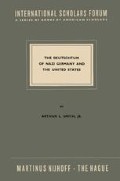Abstract
The period from December 1935 until June 1936, was really one of transition for the membership of the Friends of New Germany since, in that period, a new national leader was selected, and the name of the organization — so publicized by the Congressional investigation — was changed to the German-American Bund. The next few years were to be the most controversial and climactic in the short history of National Socialism in America.
Access this chapter
Tax calculation will be finalised at checkout
Purchases are for personal use only
Preview
Unable to display preview. Download preview PDF.
References
Kuhn was, throughout the life of the Bund, a controversial figure, and much was written about him He was born in Munich in 1896, served in World War I, as a lieutenant in the German army, and like many of the early Hitler followers, left Germany after the break-up of the Party in 1923. Kuhn emigrated to the United States via Mexico, in 1924, and turned up later in Detroit as a chemist for the Ford Motor Co.
This is the opinion of Austin G. Chambers in an unplublished master’s thesis, “The German-American Bund and German-American Diplomatic Relations, 1936–194.1” (Stanford University, 1961), p. 8. In German literature during the Hitler era Germans living in America were always referred to as “Amerikadeutsche” and as formerly, “Deutschamerikaner.” Paechter, p. 17.
German Records, 3/141/0I 79046.
The Bund had the Deutscher Weckruf and Beobachter in Chicago, Philadelphia, and California as well as the New York paper edited by Kappe, and later Severin Winterscheidt after Kappe left for Germany in the summer of 1937.
German Records, 25/394/5135808–5135823. The Bund also received material from the Weltdienst or World Service, a propaganda agency located at first in Erfurt and later Frankfurt a.M., and subsidized by the government. The head was a retired army officer named Ulrich Fleischhauer.
Ibid., 5135820. The U.S. Nazis had a longstanding feud with the Ridder family and the New York Staats zeitung, dating back to actual attempts to put pressure on the paper to fall into line with the National Socialist propaganda.
The American Ambassador to Germany, Dodd, wrote that he was quite sure Kuhn was a representative of “Bohle of the Foreign Office of the Nazi Party.” Ambassador Dodd’s Diary, p. 340. An American government agent wrote: “The Nazi organization for America starts in Germany with Ernst Bohle and his Auslands bureau.” Richard Rollins, I Find Treason ( New York: William Morrow and Co., 1941 ), p. 204.
I.M.T., Vol. X, p. 41. Bohle, when questioned on this subject at Nuremberg, denied all connection with the Bund. Ibid.
Doc. on Ger. For. Pol., Ser. D, Vol. 1, pp. 632–633.
It is not likely that just Gilbert’s action alone precipitated a whole reappraisal of German policy toward the Bund as one researcher has claimed. Joachim Remak “`Friends of New Germany’: The Bund and German-American Relations,” The Journal of Modern History, XXIX (March, 1957 ), p. 9.
Doc. on Ger. For. Pol., Ser. D., Vol. 1, pp. 636–637.
Ibid., 5301157–5301159. Most of these reports were dated around March, April and May of 1941.
Ibid., 5301177. An earlier comment by German Consul Borchers seemed closer to the truth when he wrote the Foreign Office: “Germany has, in the Bund, fashioned herself a tool which, by adopting all National Socialist views but cleverly cloaking its aims, has taken upon itself the task of destroying the United States from within by awakening dormant racial feelings and promoting those which are already more or less active. This attitude has, as a result of years of propaganda, mistakes of the Bund, and perhaps also, occasionally, as a result of misunderstandings on the part of Reich Germans, today become a deep-rooted conviction with the overwhelming majority of Americans.” Doc. on Ger. For. Pol., Ser. D, Vol. IV, p. 677.
Author information
Authors and Affiliations
Rights and permissions
Copyright information
© 1965 Martinus Nijhoff, The Hague, Netherlands
About this chapter
Cite this chapter
Smith, A.L. (1965). The Dai and the German-American Bund. In: The Deutschtum of Nazi Germany and the United States. International Scholars Forum, vol 15. Springer, Dordrecht. https://doi.org/10.1007/978-94-015-0931-2_4
Download citation
DOI: https://doi.org/10.1007/978-94-015-0931-2_4
Publisher Name: Springer, Dordrecht
Print ISBN: 978-94-015-0363-1
Online ISBN: 978-94-015-0931-2
eBook Packages: Springer Book Archive

